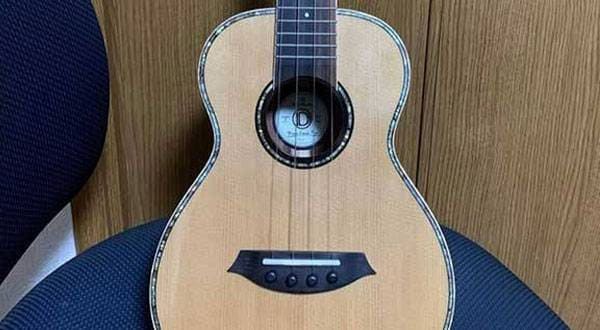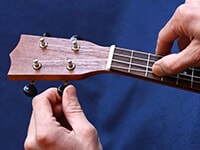Hello, this is Conservario.
Many people think that the ukulele is only for Hawaiian and pop music, but that’s not true at all!
You can play jazz, blues, country—basically anything!
In this article, I’ll introduce some classic jazz chord progressions and how to play them.
■ Can You Play Jazz on the Ukulele?
If I start explaining what jazz is...
This article will turn into an extremely long essay—so I’ll skip that part for now!
Even without an explanation, most of you probably have a sense of what ‘jazz-like’ music sounds like.
Let’s start by playing a progression that gives off a jazzy vibe.

Dm7 → G7 → CMaj7
This is called the II-V-I (Two-Five-One) progression.
I could go into details about cadence, scale degrees, and harmonic functions, but let me keep it simple (I promise I’m not just being lazy—just making it easier to read!).
If you analyze famous songs, you’ll notice that this progression appears so frequently that it even has its own shorthand notation.
Use only downstrokes.
—Either with your thumb or index finger.
Play it like: “Jaan, Jaan, Jaan”
Do you notice how it feels ‘resolved’ when you land on CMaj7?
This feeling of resolution is called cadence in music theory.
If you play this and casually say, “Yeah, II-V-I always has such a satisfying resolution,” you might sound pretty knowledgeable!
Now, let’s take it a step further and make the pArogression even more stylish.

Dm7 → D♭7 → CMaj7
Here, I’m swapping G7 for D♭7.
Even though I changed the chord, it still has a similar feel—but now it sounds even jazzier!
This uses a concept called substitute dominant.
If you want to dive deeper into this, you’ll probably find it in the second half of a music theory book.
Play the first two chords arpeggio-style and the final chord with a strumming motion.
It should sound like: “Porororo, Porororo, Jaan.”
For the arpeggio, it’s best to use all four fingers of your right hand.
You can also pluck with just one finger, but adding contrast between the arpeggio and the final strum will sound more elegant.
Of course, whether it sounds “elegant” is subjective.
Experiment and find the style that feels right for you!
Here’s another famous jazz chord progression.

CMaj7 → Am7 → Dm7 → G7
This chord progression is commonly used not only in jazz but in many other genres as well.
Unless you’re a devoted fan of avant-garde or progressive music, you’ve probably heard it at some point!
If you take a closer look, the last two chords (Dm7 → G7) are the same II-V movement I introduced earlier.
Because this progression resolves so smoothly back to CMaj7, it’s often played in a repeating loop.
A simple strumming pattern is a great starting point.
Once you’re comfortable, try incorporating arpeggios to add more musical expression!
The three progressions I’ve covered today are very simple and common for jazz players.
If you want to dive deeper into jazz harmony, check out a book called “The Real Book”.
To be honest, only a handful of musicians can fully utilize this book, but if you’re serious about learning jazz, it’s an essential resource!
Playing jazz progressions is one thing, but listening is just as important.
No matter how well you play jazz chords, if you don’t actively listen to jazz music,
it’s hard to capture the right nuance and feel.
It doesn’t matter if it’s on a ukulele, piano, saxophone, or any instrument.
Just listen to as much jazz as possible!
■ Conclusion
In this article, I introduced some common jazz chord progressions and how to play them.
If you used to think jazz was too difficult, I hope this changed your perspective!
On the other hand, if you’re used to simple chords, today’s progressions may have felt challenging.
And if you’re already familiar with jazz chords, they might have seemed too basic.
I don’t know your individual skill level, but one thing I’d like to emphasize is: Simple does not mean bad.
Many musicians—beginners, intermediate players, and even professionals—tend to think this way, which is quite surprising.
Of course, everyone is entitled to their own perspective...
but dismissing simplicity is truly a missed opportunity.
Simple playing has its own unique beauty.
It’s natural to admire complex techniques, but don’t fall into the trap of thinking that’s all that matters.
This applies not just to jazz, but to any style of music.
Thank you for reading until the end!
The “sound & person” column is made up of contributions from you.
For details about contributing, click here.












![[Enjoy the Ukulele Even More!] Do I Have to Practice the Basics?](/contents/uploads/thumbs/5/2022/2/20220221_5_16789_1.jpg)
![[Enjoy the Ukulele Even More!] Ukulele Condition Check You Should Do](/contents/uploads/thumbs/5/2022/2/20220214_5_16699_1.jpg)
![[Enjoy the Ukulele Even More!] Basic Knowledge Before You Start Playing](/contents/uploads/thumbs/5/2022/2/20220214_5_16700_1.jpg)

![[Enjoy the Ukulele Even More!] Practice that You Can Do Even Without Your Ukulele](/contents/uploads/thumbs/5/2022/1/20220131_5_16448_1.jpg)
 ウクレレのチューニング方法
ウクレレのチューニング方法
 ウクレレの各部名称
ウクレレの各部名称
 ウクレレの種類
ウクレレの種類
 ウクレレスタートガイド
ウクレレスタートガイド
 めちゃラク!ギター講座
めちゃラク!ギター講座
 ウクレレ初心者講座
ウクレレ初心者講座















